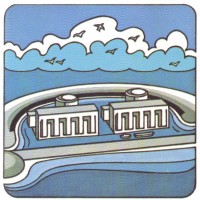A message from Studsvik Scandpower
About Studsvik Scandpower

This column was initially published in the October 16, 2014, issue of Fuel Cycle Week and is republished here with permission.
On March 31-April 1, Nuclear Energy Insider held its 4th Annual Small Modular Reactor (SMR) conference in Charlotte, NC (following on the 2nd ANS SMR Conference in November 2013-for notes and report from that embedded topical meeting, see here).
I had an interesting conversation with some colleagues last night. We were talking about our jobs, and it turned out that some of them were considering moving on to new prospects outside of the nuclear industry. After digging in to the reasons why, the sentiment seemed to come down to "It feels like we're running as hard as we can only to gain inches every day."
Presenting a new nuclear energy TV commercial - unveiled at the 2013 American Nuclear Society Annual Meeting this week!
 The US Department of Energy has a $452 million program to share development and licensing costs for selected small modular reactor (SMR) designs. The DOE's goal is to have an operating SMR by ~2022. Last November, the DOE awarded the first grant to the B&W mPowerTM reactor. In more recent news, the DOE has decided to issue a follow-on solicitation to enter a similar cost-sharing agreement with one or more other SMR vendors (and their SMR designs). The status of development and licensing for several SMR designs are summarized below.
The US Department of Energy has a $452 million program to share development and licensing costs for selected small modular reactor (SMR) designs. The DOE's goal is to have an operating SMR by ~2022. Last November, the DOE awarded the first grant to the B&W mPowerTM reactor. In more recent news, the DOE has decided to issue a follow-on solicitation to enter a similar cost-sharing agreement with one or more other SMR vendors (and their SMR designs). The status of development and licensing for several SMR designs are summarized below.
 Recent announcements and news stories about a Russian project to build a floating and essentially portable nuclear power plant have been variously tabbed with the heading "new." The idea of a floating, mobile nuclear plant (which is not self-propelled and not a ship) is indeed not new-the nuclear barge STURGIS, itself a converted Liberty Ship, served as a power source for the Panama Canal for many years, beginning back in 1967. The new Russian plants bring extra excitement because they are classed, properly, in the now-popular small modular reactor plant category, having been based on true seagoing designs. This, of course, hints at the fact that their output will not approach that of any of the large, conventional nuclear plants familiar today.
Recent announcements and news stories about a Russian project to build a floating and essentially portable nuclear power plant have been variously tabbed with the heading "new." The idea of a floating, mobile nuclear plant (which is not self-propelled and not a ship) is indeed not new-the nuclear barge STURGIS, itself a converted Liberty Ship, served as a power source for the Panama Canal for many years, beginning back in 1967. The new Russian plants bring extra excitement because they are classed, properly, in the now-popular small modular reactor plant category, having been based on true seagoing designs. This, of course, hints at the fact that their output will not approach that of any of the large, conventional nuclear plants familiar today.
The stakes are $10 billion in contracts to build new nuclear reactors for CEZ, the Czech Republic's state-owned power utility
Construction at Vogtle units 3 and 4 and VC Summer units 2 and 3 is not going as well as many nuclear advocates would like. I'm not surprised, but neither are most people who have been involved in complex construction and technology projects that involve a lot of moving parts and numerous interested parties. Nothing that happens at those projects will change my mind that atomic fission is a superior way to produce heat and boil water. There is little chance that events at those individual projects will convince me that there is something fundamentally wrong with the advanced passive reactor plant design.
Aris Candris, Ph.D., senior advisor and a member of the Westinghouse Electric Company Board of Directors, is the recipient of the 2012 Henry DeWolf Smyth Nuclear Statesman Award. Established in 1972 by the American Nuclear Society and the Nuclear Energy Institute, the Smyth Award recognizes outstanding and statesmanlike service in the development and safe management of nuclear energy science. The award commemorates a lifetime's achievement in the peaceful uses of nuclear energy.
Europe's biggest nuclear project is chopped down from five reactors to two
The Nuclear Regulatory Commission voted unanimously on December 22 in favor of publishing the final certification rule for Westinghouse's AP1000 reactor design, instructing the agency's staff to forward the final rule, which amends Appendix D of 10 CFR Part 52, for publication in the Federal Register, expected by January 5.